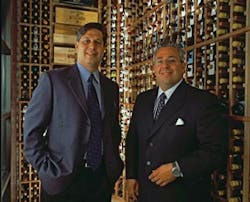As Bizav Changes, So Does Catering
SAN ANTONIO — The advent of fractional ownership of business aircraft brought with it growth and new ways of doing business for the service sector. For those who provide on board food, the changes have been dramatic, say catering officials interviewed here during the recent Schedulers & Dispatchers Conference hosted by the National Business Aviation Association. The introduction of very light jets could be the next big trend, along with taking the menu directly to the passenger by way of the Internet.
“The demographic has changed dramatically,” explains Joseph Celentano, who with his brother John operates Rudy’s Inflight Catering, based at Teterboro, NJ. “The thing that really changed it was Richard Santulli and NetJets.
“No longer are you seeing the demographic being a 65-year old man traveling to Des Moines. Fractionals brought it to a lesser net worth; all of a sudden you’re getting families and a younger demographic. It was no longer filet mignon with mushrooms and a heavy sauce. All of a sudden it’s younger people looking for healthier fare.”
Paul Schweitzer, who along with Scott Liston started up Columbus, OH-based Air Chef in 2000 after having served in FBO services for NetJets, says today’s business aviation customer is more educated and has a higher expectation level.
“There’s really not this lobster and champagne mentality,” comments Schweitzer. “The truth is, people want good, healthy food that’s interesting and packaged right. After one or two trips on a plane, they become pretty educated.”
According to Celentano, the first real breakthrough for modern bizav catering came in the form of better packaging. Upon starting the aircraft catering firm in 1984 in the family’s Rudy’s Restaurant, the Celentanos quickly realized that packaging was as important as the food itself, says Joe Celentano.
“That was really how we broke out,” he says. “We started using glass dishes, metal trays, things that weren’t commonly associated with a disposable item.”
Setting Up a Network
Both Rudy’s and Air Chef officials say their annual revenues are in excess of $20 million, and both have grown in recent years by creating a network of catering alliances and partnerships. And, both Celentano and Schweitzer say an emphasis is placed on making the process streamlined for the customer, as in one bill that itemizes. It’s a concept, they say, which the fractional providers quickly realized was important in bringing new customers to business aviation.
While both caterers saw the need to set up national and even international networks, they have taken different approaches toward the goal. At Rudy’s, the answer came in the form of its Aviation Services Network, established in 2004 originally for Flight Options, in which local caterers become catering partners with Rudy’s. “We went through a year-long process of integrating our computer systems so that they can electronically send us all of their service requests,” explains Celentano.
“We have 62 caterers in the Aviation Services Network; all are pre-qualified where we’ve gone out and done site surveys.
“We looked at it and said, there are already established caterers across the country. How do we help them elevate the level of quality, of service? Well, these are mostly small businesses. If we can help them by taking away some of the accounting, some of the marketing, customer service functions, then they can redirect their resources to take care of the most important aspect of their business, the customer.
“Fractionals were the first ones to embrace streamlining the process. Having one phone number to call to take care of a multitude of services, and one invoice associated with that transaction.
At Air Chef, explains Schweitzer, the company has taken a three-tiered approach to the marketplace: in some locations they own the local kitchen; in some they have long-term contractual agreements with local kitchens for catering; and, the third tier is ordering on an ad hoc basis to local caterers.
Says Schweitzer, “It makes sense to own kitchens in certain markets. In some markets it makes sense to have contractual arrangements with a local supplier; and in some markets we just send a catering order to a good supplier on a non-contractual basis and they provide the food.”
Air Chef is also reaching out beyond the U.S. market, entering contractual agreements recently with providers in Hawaii, Mexico, and Europe. A Paris agreement is expected to be completed later this year.
Changing Demands
Both Celentano and Schweitzer see electronic ordering via the Internet — along with electronic processing, billing, and tracking — as the next big wave and both companies have been investing heavily in the related technology. At Rudy’s, says Celentano, the company has spent a half million dollars on a new deliver and tracking system, ala the UPS delivery truck, that ensures accountability and ease of use for the customer.
At Air Chef, says Schweitzer, a recent emphasis has been on developing its online ordering system, in cooperation with Professional Flight Management and Universal Weather and Aviation, Inc. Users can order catering for flights through PFM’s flight management software and Air Chef’s ordering system.
Comments Schweitzer, “I wanted to get in front of the scheduler or dispatcher with a dedicated interface that’s in their systems everyday. This will lead, I think, in the next 18 months to where you’ll start to see passengers ordering their catering, which gets us closer to the source.”
